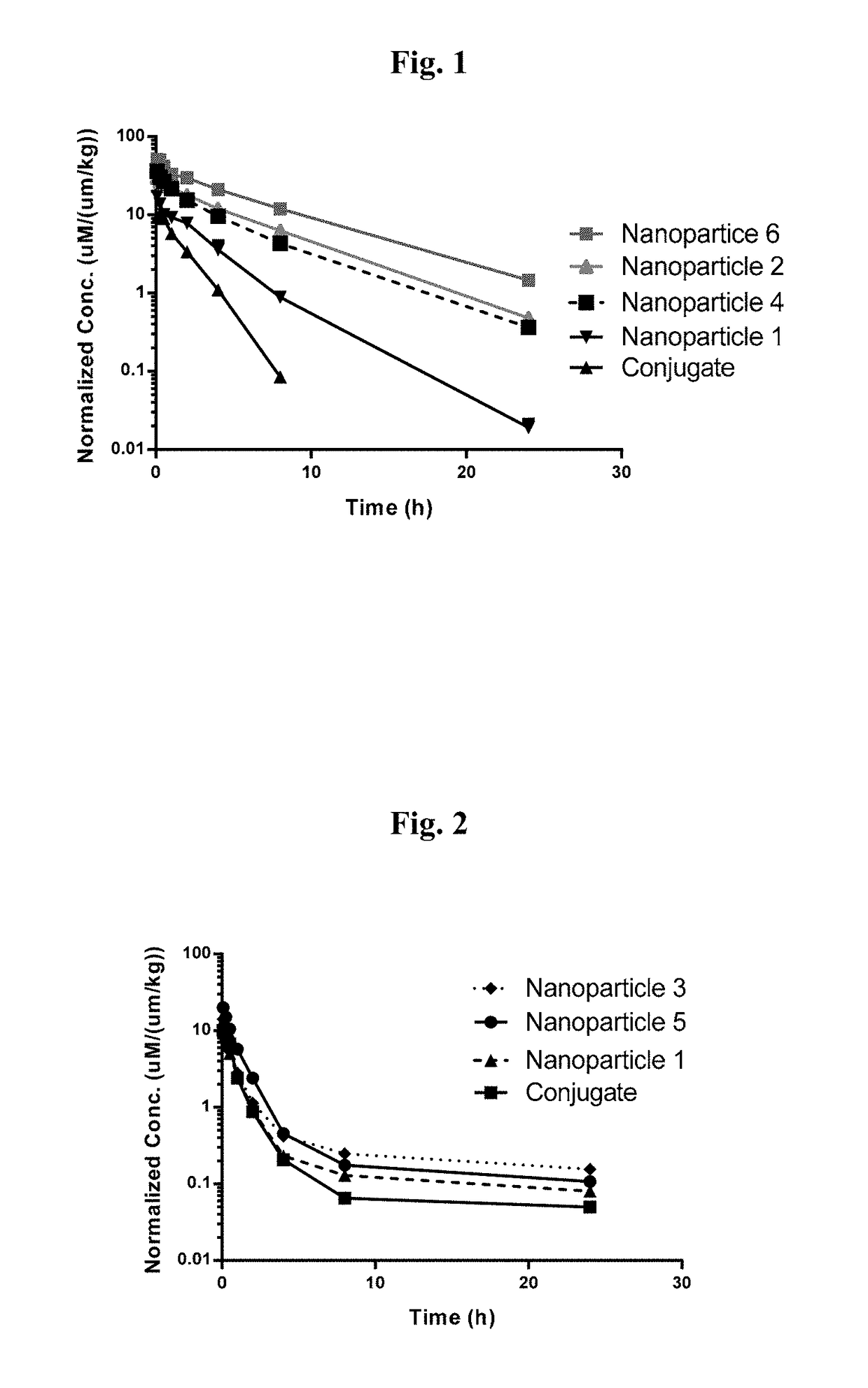Targeted conjugates and particles and formulations thereof
a technology of conjugates and particles, applied in the direction of biocide, drug composition, peptide/protein ingredients, etc., can solve the problems of limited clinical application, poor immunogenicity, and high manufacturing cos
- Summary
- Abstract
- Description
- Claims
- Application Information
AI Technical Summary
Benefits of technology
Problems solved by technology
Method used
Image
Examples
example a
HPLC Analytical Methods: Analysis of the Product by C18 Reverse Phase HPLC (Method 1)
[0386]HPLC analysis of the compounds described herein was carried out on Zorbax Eclipse XDB-C18 reverse phase column (4.6×100 mm, 3.5 μm, Agilent PN: 961967-902) with a mobile phase consisting of water+0.1% TFA (solvent A) and acetonitrile+0.1% TFA (solvent B at a flow rate of the 1.5 mL / min and column temperature of 35° C. The injection volume was 10 μL and the analyte was detected using UV at 220 and 254 nm. The gradient is shown in Table 5.
[0387]
TABLE 5GradientTime (mins)% A% B0955659585958.0195510955
example 1
Synthesis of Conjugate 1
[0388]
[0389]To a solution of cabazitaxel (2.00 g, 2.40 mmol) and 2-(2-pyridinyldithio)ethanol p-nitrophenyl carbonate (915 mg, 2.60 mmol) in dichloromethane (48 mL) was added DMAP (439 mg, 3.60 mmol). The solution was stirred at room temperature overnight, then washed with 0.1N HCl (3×20 mL), saturated aqueous NaCl (50 mL), and dried with sodium sulfate. The solvent was removed in vacuo, the the remaining residue purified by silica gel chromatography (2:1 petroleum ether:ethyl acetate) to give cabazitaxel 2-(2-pyridyldithio)ethylcarbonate (2.50 g, 2.38 mmol, 99% yield). LCMS m / z: 1049 (M+H).
[0390]
[0391]To a solution of octreotide acetate (2.08 g, 1.93 mmol) in DMF (20 mL) and diisopropylethylamine (2.0 mL), cooled to −40° C., was added a solution of BocOSu (419 mg, 1.95 mmol) in DMF (5 mL) dropwise. The reaction was gradually warmed to room temperature, over 3 hours. Most of the DMF was removed, and the reaction mixture loaded onto a C18 column, eluting with ...
example 2
Synthesis of Conjugate 2
[0396]
[0397]Octreotide acetate (515 mg, 0.477 mmol) was dissolved in DMF (6 mL) and diisopropylethylamine (1.0 mL). The solution was cooled to −40° C., and a solution of FMocOSu (182 mg, 0.539 mmol) in DMF (4 mL) was added dropwise. The reaction was gradually warmed to room temperature over 2 hours. pH 8.0 phosphate buffer (1 mL) was added, and the reaction mixture loaded onto a 50 g C18 column. Eluting with 15% to 85% acetonitrile in water gave Lys-Fmoc octreotide (419 mg, 0.337 mmol, 71% yield). LCMS m / z: 621.3 (M+2H) / 2.
[0398]
[0399]A flask was charged with doxorubicin (1.39 g, 2.40 mmol) and FMocOSu (1.69 g, 5.00 mmol). DMF (10 mL) and diisopropylethylamine (875 μL, 5.00 mmol) were added, and the reaction stirred at room temperature for 3 hours. All solvent was removed in vacuo, and the remaining residue loaded on an 80 g silica gel column, eluting with 0% to 8% methanol in dichloromethane to give FMoc doxorubicin (1.84 g, 2.40 mmol, 100% yield). LCMS m / z: ...
PUM
| Property | Measurement | Unit |
|---|---|---|
| diameter | aaaaa | aaaaa |
| diameter | aaaaa | aaaaa |
| diameter | aaaaa | aaaaa |
Abstract
Description
Claims
Application Information
 Login to View More
Login to View More - R&D
- Intellectual Property
- Life Sciences
- Materials
- Tech Scout
- Unparalleled Data Quality
- Higher Quality Content
- 60% Fewer Hallucinations
Browse by: Latest US Patents, China's latest patents, Technical Efficacy Thesaurus, Application Domain, Technology Topic, Popular Technical Reports.
© 2025 PatSnap. All rights reserved.Legal|Privacy policy|Modern Slavery Act Transparency Statement|Sitemap|About US| Contact US: help@patsnap.com



